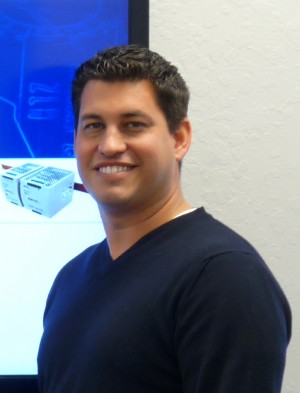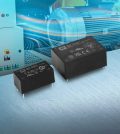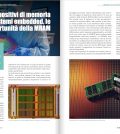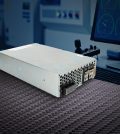Analog vs Digital, the Power struggle continues

If you are a power supply design engineer or an EE or ASE that selects power solutions for your end system, then there is no doubt you have stood at the cross roads and pondered the dilemma to go analog or digital with your power train.
The good news is we find that the actual answer lies somewhere in the middle… borrowing the best aspects of both approaches.
Power supplies are making their way up the food chain as a primary consideration when designing a new system. Historically, a power applications engineer used to spend most of their time trying to figure out how to fit the system power in the “afterthought” mechanical space left by the design team.
Today we find system engineers depending on the power supply to do more than just provide analog world attributes of conversion, conditioning, and protection supplies are now expected to handle power management as well. System engineers want to be able to communicate with the power supply and get real time information as well as be able to control the power supply enter the digital realm.
Monitoring of real time information such as voltage levels, current levels, faults, alarms, and time based logging of that information gives a systems engineer the ability to maximize system run time through predictive failure analysis and minimize downtime by having more data to offer a repair engineer.
Controlling supply translates to being able to turn outputs on and off in a fixed sequence and timing, changing output parameters such as voltage and current, and optimizing cooling fan speeds for noise minimization and fan life.
Although the monitoring and control can be achieved through analog means, we find that going to our digital tool bag is often a more practical in terms of design, support, implementation, and long term management of the power system. When you start to consider signals and control in multiple domains such as level and time, and optimizing those domains to meet your specific needs, you can see that changing firmware is much more manageable than dialing in resistor values during initial system evolution.
Digital management literally allows for a vendor to email you a new file for upload to the monitoring and control chip to see if your new configuration works. If not, go right back to the old configuration and create another one. No change to hardware means faster integration and lower cost of integration.
The dawn of digital in power supplies initially focuses on the PWM and the main switching control of the supply. Although being able to digitally change and monitor critical core parameters of the supply seemed appealing at first, we have found that the benefits that come with a digital “heart”, in most cases, are not justified when weighed against the complications associated with a DSP design.
Analog is still king when it comes to the core power conversion it’s tried and true, trusted in the industry, more readily available, and has shorter design cycles and “bugs” when it comes to new product releases. We also want some of the benefits we discovered on our digital design journey, so we have held on to those, but on a secondary level of monitoring and control. The root alarm and control circuits are analog, but the interface to those circuits are filtered thought a digital layer that gives us the best of both worlds.
They may be a time where DSP becomes the norm, but for now, the way I see it, analog is going to be around for a while but living in harmony with the digital benefits power management systems are begging for in today’s marketplace.
Jeff Rodriguez, VP of Engineering Services, XP Power
Contenuti correlati
-
XP Power presenta convertitori DC-DC da 150W/200W
I convertitori DC-DC della serie RDF di XP Power offrono potenze nominali di 150W e 200W e sfruttano un sistema di raffreddamento di tipo baseplate. Questi moduli sono caratterizzati da una tensione di ingresso particolarmente ampia (nominale...
-
XP Power inaugura lo SVIC a San Jose
SVIC è l’acronimo di Silicon Valley Innovation Center, la nuova struttura inaugurata da XP Power a San Jose, in California. Gli 8.000 metri quadrati ospitano l’Headquarter in Nord America, ma anche le aree per ricerca e sviluppo,...
-
XP Power: convertitori DC-DC per usi medicali
XP Power ha esteso la sua offerta di convertitori DC-DC ultracompatti con le nuove serie JMR03/10/20 da 3W, 10W e 20W, approvate per uso medicale. Questi dispositivi incapsulati forniscono infatti 2 x MOPP con una corrente di...
-
Alimentatori certificati OVC III da XP Power
XP Power ha realizzato una nuova serie di alimentatori certificati OVC III (categoria di sovratensione III) con ingresso ultra-wide da 85-528 VAC per applicazioni di automazione industriale e apparecchiature in edifici commerciali e residenziali. La nuova serie...
-
Usare dispositivi GaN per ridurre le dimensioni degli alimentatori c.a./c.c. medicali esterni
Oltre a soddisfare i severi standard in vigore nel settore medicale, gli alimentatori c.a./c.c. di XP Power utilizzano dispositivi GaN che permettono di dimezzare le dimensioni rispetto ad analoghi prodotti basati sui classici dispositivi in silicio Leggi...
-
XP Power presenta nuovi alimentatori da 550W per applicazioni medicali e industriali
La nuova serie di alimentatori AC-DC a basso profilo da 550W di XP Power comprende modelli approvati per l’utilizzo sia in applicazioni mediche che industriali. Questi alimentatori, utilizzabili con raffreddamento a convezione naturale, a conduzione o ad...
-
Progettazione di alimentatori per applicazioni medicali: cinque considerazioni chiave
Con il continuo sviluppo di nuove tecnologie e apparecchiature a supporto dell’assistenza sanitaria, questo mercato in continua crescita necessita di soluzioni di alimentazione robuste e affidabili, destinate a un’area che è forse l’apice di ciò che può...
-
Dispositivi di memoria per sistemi embedded, le opportunità della MRAM
Il sistema di memorizzazione basato su tecnologia magnetoresistiva è di tipo non volatile e fornisce diversi benefici rispetto alle convenzionali memorie SRAM e DRAM. In virtù delle proprie caratteristiche, la tecnologia MRAM può soddisfare differenti casi d’uso in...
-
XP Power: alimentatori programmabili da 3 kW per applicazioni mediche e industriali
XP Power ha annunciato la nuova serie di alimentatori programmabili da 3 kW 3HPF3K0 utilizzabile nel settore medico. Sono disponibili quattro varianti con uscite singole nominali da 24, 36, 48 e 60VDC. L’efficienza raggiunge il 93% e...
-
Difesa e Aerospazio; il ruolo degli amplificatori di potenza
Grazie ai PA MMIC in nitruro di gallio è possibile affrontare in maniera efficace le complesse problematiche legate alla realizzazione di sistemi per comunicazioni satellitari militari, radar e 5G Leggi l’articolo completo su EO 514


















